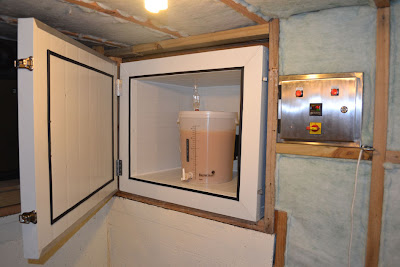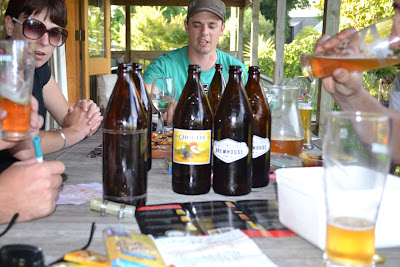My husband loves beer and has been a keen brewer for a number of years. Over the last few weeks he has been keeping himself busy downstairs in his 'man shed' and after becoming a bit concerned over his absence, I thought I would venture down to his workshop to investigate....
Thankfully he was doing something productive! Check out these clever brewing aids....
A kitchen sink operated bottle rinser, holding 16 bottles...
Made with garden hose irrigation tubes and sprinklers....
And keeping colour coordinated to match the bottle tree :)
And a digital temperature controlled fully insulated fermenting cupboard!
Holds not just one, but two fermenting buckets!! Perfect for summer and winter to keep those brews at the right temp throughout the fermentation process :)
Thursday, 9 February 2012
Wednesday, 1 February 2012
Homebrew Competition
I was privileged enough to be invited to an inhouse homebrew competition organised by some enthusiastic electricians who work at the Tip Top icecream factory in Auckland. The group consisted of 6 guys and 1 girl and there were 11 brews to taste test.
This was going to be a long evening... safe drinking practices were implemented with homemade pizzas also on offer using the host's ingenius Weber bbq pizza oven.
Nick's India pale ale had some good head, but don't waste it all!
That sure was a tasty drop, scores out of 10 for taste, aroma, appearance and the 'x' factor...
The other brews on offer were a Hoegaarden, Pilsner, Summer Ale and even an all grain experiment!
While the group were intently scoring the entries, delicious pizzas were being cooked in the Weber pizza oven...
Over the half way mark now with 4 more beers still to try... the winners are beginning to stand out... the group were competing for the new British Series pouches for first and second prize and a Dutch lager recipe kit for third...
 First prize went to Brent for his delicious pear cider which had the highest score of the night - 31 out of 40! The group were blown away by this cider, many saying it was the best cider they have ever tasted from a homebrew kit!
First prize went to Brent for his delicious pear cider which had the highest score of the night - 31 out of 40! The group were blown away by this cider, many saying it was the best cider they have ever tasted from a homebrew kit! He won a Mangrove Jack's apple cider to try out next :)
Nick took out second with his pale ale, brewed straight from the can with no additions...
and third place went to Rich with his own take on a summer ale - manuka honey, ginger and orange zest adding to that summery flavour!
For more information about our new British Series kits - check out our website - mangrovejacks.com
Wednesday, 16 November 2011
The British Series
We are proud to introduce our brand new range of Premium beer kits, The British Series.
Made in the U.K using the latest ‘Cold Fill’ technology, each pouch is nitrogen flushed to retain the delicate flavours and aromas, with high quality malts and single strain beer yeasts used to complement each specific beer style.
6 popular flavours available now with more to come, these premium beers are serious about quality.
Find out more about these great kits on our website - www.mangrovejacks.com
Wednesday, 17 August 2011
Hops - What are they and what will they do to your beer?
 Put simply, hops are the seasoning in beer and are used to create bitterness to balance out the sweetness of the malt. Each hop variety carries it's own unique flavours and aromas that also contribute to the final taste of the beer. Below is a list of some popular hop varieties detailing their characteristics and the types of beer they will taste best with.
Put simply, hops are the seasoning in beer and are used to create bitterness to balance out the sweetness of the malt. Each hop variety carries it's own unique flavours and aromas that also contribute to the final taste of the beer. Below is a list of some popular hop varieties detailing their characteristics and the types of beer they will taste best with. Cascade - Citrusy, floral and aromatic - Best with American Ales (Amarillo can be used as a substitute)
Fuggles - Traditional British aromatic - Best with British and American Ales
Goldings - Mildly aromatic and bitter - Best with bitters, stouts and pales
Hallertau - German aromatic hop - Best with lagers and Pils
Saaz - Aromatic and bitter - Best with European lagers, Pils, Belgian beers
Tettnanger - Spicy, noble aromatic hop - Best with lagers, Pils and Kolsch beers
Monday, 8 August 2011
Beer Glasses - Why are they important?
If you've been wondering why your beers have little or no head, the solution could be as simple and easy as this - Try a different glass!
You may not realise, but the shape, material and thickness of your glass can have an effect on your beer and more importantly, it's head. Thicker glasses will warm slower, therefore will improve the persistence of the foam. Any marks or etches in the bottom of the glass also play an important part by agitating the bubbles and sending them to the surface which releases more aromas. Some companies have been known to purposely etch marks into their glasses to create this effect!
The head not only looks good but also contains a lot of the delicious hop and spice aromas that make a beer so irresistible, so by pouring your beer into the right glass, you are not only maintaining the froth, but also letting all those great aromas mingle with the CO2 bubbles and concentrate the flavour of your beer.
So what about shape? Well, snifter and tulip shaped glasses are ideal for capturing the aromas because of their narrow brim and wider base and are also great for maintaining a good head. The tall pilsner glass is popular for proper head and lighter beers as they accentuate the colour and clarity of the beer. Steins, mugs and pint glasses hold more volume and are more sturdy but are poor when it comes to head and clarity.
And last but certainly not least, in fact probably most important of all - Always make sure your glasses are clean! Oil or grease residues from the kitchen can severely effect the head of your beer, and bad odours on the glass can turn even the most dedicated beer drinker away.
You may not realise, but the shape, material and thickness of your glass can have an effect on your beer and more importantly, it's head. Thicker glasses will warm slower, therefore will improve the persistence of the foam. Any marks or etches in the bottom of the glass also play an important part by agitating the bubbles and sending them to the surface which releases more aromas. Some companies have been known to purposely etch marks into their glasses to create this effect!
The head not only looks good but also contains a lot of the delicious hop and spice aromas that make a beer so irresistible, so by pouring your beer into the right glass, you are not only maintaining the froth, but also letting all those great aromas mingle with the CO2 bubbles and concentrate the flavour of your beer.
So what about shape? Well, snifter and tulip shaped glasses are ideal for capturing the aromas because of their narrow brim and wider base and are also great for maintaining a good head. The tall pilsner glass is popular for proper head and lighter beers as they accentuate the colour and clarity of the beer. Steins, mugs and pint glasses hold more volume and are more sturdy but are poor when it comes to head and clarity.
And last but certainly not least, in fact probably most important of all - Always make sure your glasses are clean! Oil or grease residues from the kitchen can severely effect the head of your beer, and bad odours on the glass can turn even the most dedicated beer drinker away.
Thursday, 14 July 2011
The Dandy Shandy
A great winter's take on the traditional shandy recipe, what better time to brew a Mangrove Jack's Irish Stout!
Subscribe to:
Comments (Atom)














